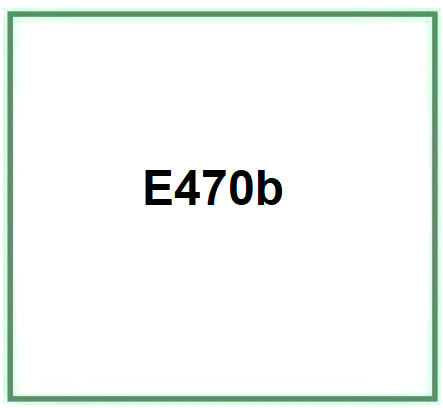E470b is an ingredient on the list of European food additives as an emulsifier also known as Magnesium salts of fatty acids or Magnesium Stearate is a chemical compound, magnesium salt of stearic acid (octadecanoic acid).
The name defines the structure of the molecule:
- Magnesium is a chemical element with the symbol Mg and the atomic number 12. It is a metal and is essential for many biological processes.
- Stearate refers to the stearic acid part of the molecule. Stearic acid is a fatty acid with eighteen carbon atoms.
The synthesis process takes place in several stages:
- Preparation of stearic acid. Stearic acid is obtained from fats and oils from the saponification or hydrolysis process, followed by isolation.
- Reaction with magnesium salt. Stearic acid is reacted with a magnesium salt, such as magnesium oxide or magnesium carbonate, in an aqueous solution. This reaction forms magnesium stearate and a by-product, such as water or carbon dioxide.
- Precipitation. Magnesium stearate is insoluble in water, so it precipitates out of the solution. The solution is cooled to promote precipitation.
- Filtration and washing. The precipitated magnesium stearate is separated from the solution by filtration. It is washed with water to remove any remaining impurities.
- Drying. Wet magnesium stearate is dried to remove residual water by air drying or using a drying oven.
- Quality control test. The final product is tested to ensure it meets the required specifications. This may involve testing for purity, moisture content and other physical and chemical properties.
It occurs as a light, white, fine powder, insoluble in water, ethoxyethane, ethanol, ether. Soluble in hot water, hot ethanol. On contact with acids it decomposes into stearic acid and magnesium sal's salts. Commercially it is not pure, but it is a mixture of Magnesium Stearate and Magnesium Palmitate (C32H62MgO4) extracted from palm oil.

Magnesium stearate has four types of pseudopolymers: monohydrate, dihydrate, trihydrate, anhydrate.
What it is used for and where it is used
Medical
In the pharmaceutical industry, it is an excipient for solid oral dosage forms. It is used as an essential lubricant in production for tablet dissolution, disintegration and hardness.
Hydroxypropyl methyl cellulose can prevent drug precipitation caused by magnesium stearate (1). It is used as a lubricant in the nanoprecipitation/ion exchange method (2). This study investigates magnesium stearate used as an essential lubricant in tablet production and its effect on tablet dissolution, disintegration and hardness (3).
Other uses
In the plastics industry it is used as a lubricant and stabiliser for cellulose acetate, polyvinyl chloride, ABS, resins etc.
Cosmetics
Anticaking agent. This compound facilitates free flow and prevents aggregation or clumping of substances in a formulation by reducing the tendency of certain particles to stick together
Bulking agent. It regulates the water content, dilutes other solids, can increase the volume of a product for better flow, acts as a buffer against organic acids, helps to keep the pH of the mixture within a certain level.
Moisturizing. This ingredient is responsible for preventing the evaporation of moisture from the skin and improving cellular activity. When exposed to cold or hot air currents, the skin absorbs water from its inner layer to compensate for the evaporated water. If the draught phenomenon persists, the stratum corneum is dry and, if at all, damaged.
The most relevant studies on this chemical compound have been selected with a summary of their contents:
Magnesium Stearate studies
Optimal typical characteristics of Magnesium Stearate as a commercial cosmetic product
| Appearance | white powder |
| Density | 1.069 g/ml 1.028g/cm3 |
| Magnesium content | 4.0-5.0 % |
| pH | 7 (H₂O) |
| Chloride | ≤0.1 % |
| Sulfate | ≤1.0 % |
| Loss on drying | ≤6.0 % |
| Lead | ≤10 ppm |
| Nickel | ≤5 ppm, |
| Cadmium | ≤3 ppm |
| Stearic acid content | ≥40.0~≥65.0 % |
| Stearic acid and palmitic acid content | ≥90.0 |
| Melting point | 200 °C(lit.) |
| Shelf life | 24 months |
- Molecular Formula C36H70MgO4 Mg(C18H35O2)2
- Linear Formula [CH3(CH2)16CO2]2Mg
- Molecular Weight 591.257 g/mol
- Exact Mass 590.512451
- CAS 557-04-0
- EINECS 209-150-3
- UNII 70097M6I30
- DSSTox Substance ID: DTXSID2027208
- MDL number MFCD00036391
- PubChem Substance ID 24865972
- InChI Key HQKMJHAJHXVSDF-UHFFFAOYSA-L
- SMILES CCCCCCCCCCCCCCCCCC(=O)[O-].CCCCCCCCCCCCCCCCCC(=O)[O-].[Mg+2]
- IUPAC Name magnesium;octadecanoate
- ChEBI CHEBI:9254
- Beilstein 3919702
- NACRES NA.22
Synonyms:
- Stearic acid magnesium salt
- Magnesium octadecanoate
- Magnesium distearate
- magnesium dioctadecanoate
- Octadecanoic acid, magnesium salt
- Dibasic magnesium stearate
- octadecanoic acid magnesium salt
References_________________________________________________________________________
(1) Démuth B, Galata DL, Balogh A, Szabó E, Nagy B, Farkas A, Hirsch E, Pataki H, Vigh T, Mensch J, Verreck G, Nagy ZK, Marosi G. Application of hydroxypropyl methylcellulose as a protective agent against magnesium stearate induced crystallization of amorphous itraconazole. Eur J Pharm Sci. 2018 Aug 30;121:301-308. doi: 10.1016/j.ejps.2018.06.008.
(2) Martínez-Acevedo L, Zambrano-Zaragoza ML, Vidal-Romero G, Mendoza-Elvira S, Quintanar-Guerrero D. Evaluation of the lubricating effect of magnesium stearate and glyceryl behenate solid lipid nanoparticles in a direct compression process. Int J Pharm. 2018 Jul 10;545(1-2):170-175. doi: 10.1016/j.ijpharm.2018.05.002.
(3) Yamamoto K, Tamura T, Yoshihashi Y, Terada K, Yonemochi E. Effect of Magnesium Stearate Mono- and Dihydrate Dispersibilities on Physical Properties of Tablets. Chem Pharm Bull (Tokyo). 2017;65(11):1028-1034. doi: 10.1248/cpb.c17-00429.
![]() E470b
E470b 






